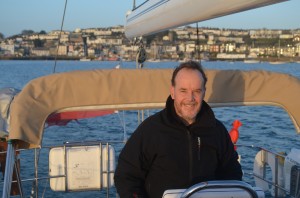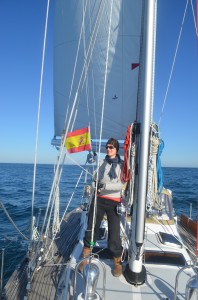We had been waiting in Falmouth for two and a half weeks for a weather window to cross The Bay of Biscay to Spain. People were asking "Are you still in Falmouth?". Tom was starting to get a little narked, it was time to get that tracker fired up...

- Leaving Falmouth
So on Friday 19th April at 0640, Adina slipped quietly out of Falmouth and started heading south. Our planned destination was Bayona, Spain, a
four and a half day sail away.
Biscay is a notorious stretch of water in sailing lore. Robin Knox-Johnston said at the start of the Vendee Globe Round the World yacht race that the waves were so steep it was like trying to sail a yacht up Mount Everest. Ironically, after weeks of heavy winds and seas the forecast for us was for light winds.
For any other Brits heading for the Canaries for the start of the
Atlantic Rally Crossing in November, I would highly recommend
Frank Singleton's page. My own recommendations from doing research would be to emphasise not just looking at the wind, but study the sea state. An excellent app for iPads is WeatherTrack which gives wind and wave heights in an easy visual format. Critically remember there is a lag of about 12 hours between winds and sea state. The winds might be light but the sea state could still be rough. Of course you could be very lucky and get the opposite of good wind and a calm sea state!
Popular routes across Biscay are Falmouth or Plymouth to La Coruna or further onto Bayona. We chose Bayona wanting to get more miles in. But here the weather around Cabo Finnisterre must be monitored. The amount of wind farms we saw on the land there speaks volumes. I would also argue for having a plan to cross to France when you cannot find 4 days of reasonable weather as this will cut a day out. That was our Plan B but in the end Plan A came through. And be patient, don't rush it, it's not notorious for no reason.
We got off to a good start with nice winds even if the sea state was still very rough. But Adina likes slicing waves. People often comment it feels smoother down below than on deck. But come night fall as we approached France, the winds dropped and on came the motor.
For us this crossing was a new experience, our first long voyage double-handed. We had a 3 hours on, 3 hours off system. But this quickly evolved into doing what we wanted during daylight and then following the watch system at night. There were about nine hours of darkness so night shifts started at 9pm and we alternated who would take the first shift each night as that person would get six hours of being
on watch by moonlight, whilst the other got only three.
Being a light sleeper, Tom hardly slept perhaps getting 6 hours of sleep during the whole crossing. Insomnia was my sleeping partner!
When there is wind, we both love to helm. Autopilots rank up there with my love for Ugg boots (that's me in trouble!), although I admit when you're tired or the motor is on they are a godsend and admittedly better at
keeping you on track.
Hours were taken up reading, writing, looking at the navigation, checking on the ships around us, trying new knots out and Susie giving Tom some basic Spanish lessons. "Un cafe con leche, sin chocolate par favor". Bless the poor up-and-coming Spaniards who will suffer.

- Adina under attack! Tracking ships on the screen plotter.
Our route meant we were in the direct line of ships doing the same thing heading to and from Southern Europe and beyond. But we were impressed as they all gave us a wide berth in good time and we never had to move for a ship nor radio them to ask them to move. At night time we heard the ships talking to each other more. Our favourite was one irate Russian talking to another ship clearly on a collision course "Hey! Move to starboard - where do you buy your captain license?!" Or the slightly nervous French fisherman calling a 300m cargo ship "Eh, I am a fishing vessel, you seen me?"
Soon we were into Biscay Bay and even in light winds the swells were impressive. We had
spells of winds from anything between 3 to 12 hours and we both gloriously enjoyed helming and trying to trim our sails. Goddamn cruising boats, they just don't trim like racing boats and I think my days of going round the world are going to be tormented on that front. Indeed I'm going to destroy our budget and buy myself a nice set of sails at some stage! "Susie, we need more outhaul" "No, we don't. Last time you did that, you ripped the sail". "Mutter, mutter..." Needless to say Susie controls the pit.
I was saying to Susie it would be nice to have some dolphins. Cue an hour
later, dolphins! And they accompanied us for 6 hours as we motored on a starry night. It's impressive how they keep up, darting around. In the dark we could see silvery streaks dashing through the water, as they shot backwards and forwards playing at Adina's bow, dashing underneath her hull. Just a joy to watch. Alas they disappeared as the sun rose when a large cruise ship passed by. Dolphins I'm told are rather clever and they must have worked out kippers were on the menu on the cruise ship versus our porridge with bananas, raisins and dollops of honey.

- Cruise ship at dawn
I'd also wondered if we'd get any birds joining us for a ride as you do hear such stories. "Susie, what is that chirping sound? It's odd, just like a bird". Indeed we had a little bird on board taking
shelter in one of our windows. But this is a sad little story friends, as despite the offering of some of the finest English porridge oats, little Alf popped his clogs, and was found passed away on deck hours later. We granted him his final wish for a burial at sea.
Biscay and its large swelly seas were soon passed and the corner of Spain could be seen. Ahead lay Cabo Finnisterre. And we were soon experiencing its fearsome reputation. The sea picked up, the wind was at 25knots and we were reefing as Adina was being rolled around by big seas. Deep reefs helped calm it all down and we started our journey south. The winds would regularly shoot up and then die to nothing.
While we had been lucky in sailing our rhumb line, northerly winds meant we now faced gybing. But the sailing was good! I had gone inshore due to the wind direction and lighter winds, but knew I would have to gybe to avoid some sunken rocks. But suddenly the winds picked up, changing direction as they did and I was soon on a route to avoiding the rocks without needing to gybe. This was good sailing: focus hard, come on Adina, deeper, keep going, we can miss those rocks, faster, faster. Adrenalin was flowing, blood pumping, the sound of water rushing below the hull. Ever deeper, we were well clear of those rocks - good Adina! I could helm for hours on end, the only discomfort my knees aching from
standing in one spot. It's a heavenly feeling when you are hitting that sweet spot.

- Susie hoisting the Spanish courtesy flag
The winds dropped and we were slowly sailing down the Spanish coast, with Susie helming and watching out for all the fisherman going to and fro chasing the day's catch . Dawn came, the sun shone and two people gloriously shed their thermal sailing kit and sailing boots and put on t-shirts and shorts.
In no time we were sailing into Bayona, where we stayed at
the beautiful Real Monterreal Club de Yachtes amongst green hills, with a castle and blue, blue skies. We hugged, a feeling of deep satisfaction - we'd done it.
A quick change and into town we went. A seafood lunch, cold cerveza and the only two barking mad people sitting in the midday sun. Nothing but nothing was going to wipe the smiles off our faces. Biscay crossed, sunshine found.
www.yachtadina.co.uk